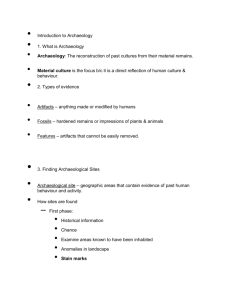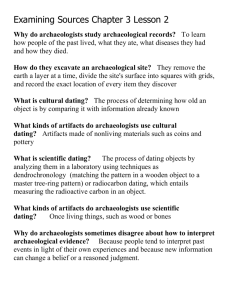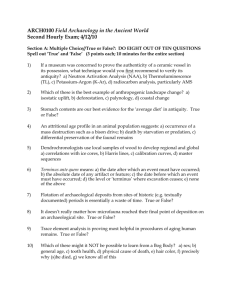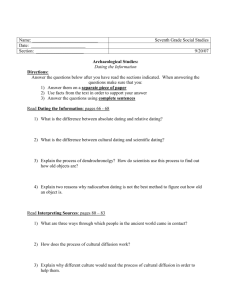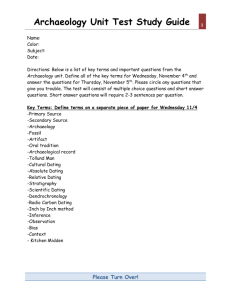Quiz #1 - Fog.ccsf.edu - City College of San Francisco
advertisement
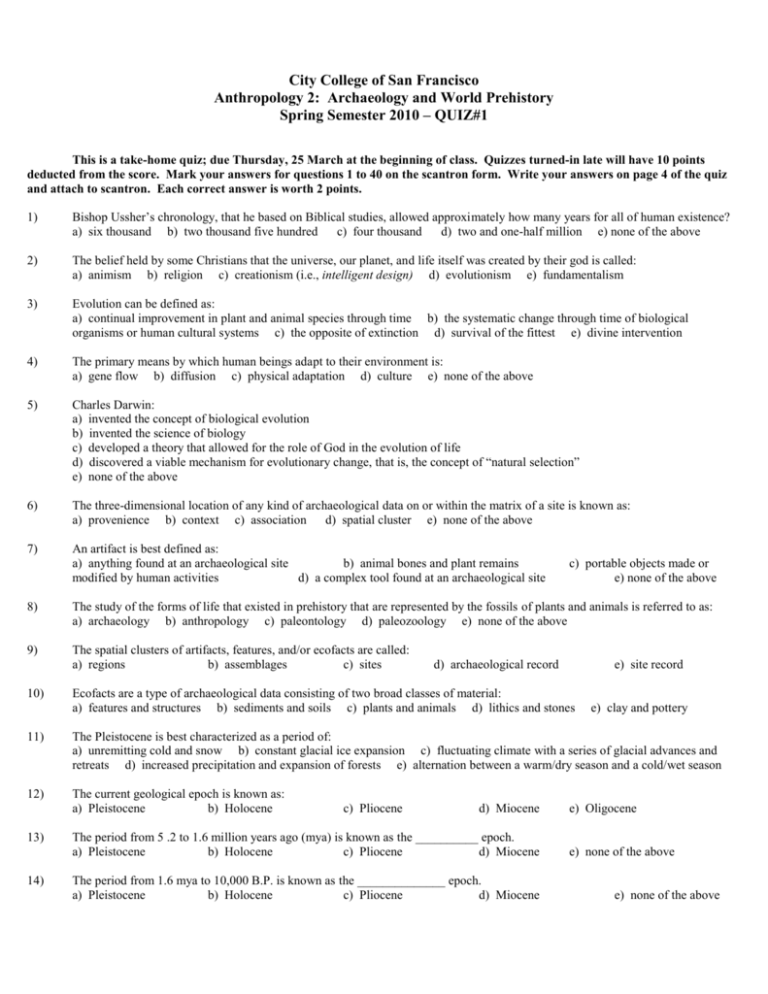
City College of San Francisco Anthropology 2: Archaeology and World Prehistory Spring Semester 2010 – QUIZ#1 This is a take-home quiz; due Thursday, 25 March at the beginning of class. Quizzes turned-in late will have 10 points deducted from the score. Mark your answers for questions 1 to 40 on the scantron form. Write your answers on page 4 of the quiz and attach to scantron. Each correct answer is worth 2 points. 1) Bishop Ussher’s chronology, that he based on Biblical studies, allowed approximately how many years for all of human existence? a) six thousand b) two thousand five hundred c) four thousand d) two and one-half million e) none of the above 2) The belief held by some Christians that the universe, our planet, and life itself was created by their god is called: a) animism b) religion c) creationism (i.e., intelligent design) d) evolutionism e) fundamentalism 3) Evolution can be defined as: a) continual improvement in plant and animal species through time b) the systematic change through time of biological organisms or human cultural systems c) the opposite of extinction d) survival of the fittest e) divine intervention 4) The primary means by which human beings adapt to their environment is: a) gene flow b) diffusion c) physical adaptation d) culture e) none of the above 5) Charles Darwin: a) invented the concept of biological evolution b) invented the science of biology c) developed a theory that allowed for the role of God in the evolution of life d) discovered a viable mechanism for evolutionary change, that is, the concept of “natural selection” e) none of the above 6) The three-dimensional location of any kind of archaeological data on or within the matrix of a site is known as: a) provenience b) context c) association d) spatial cluster e) none of the above 7) An artifact is best defined as: a) anything found at an archaeological site b) animal bones and plant remains modified by human activities d) a complex tool found at an archaeological site c) portable objects made or e) none of the above 8) The study of the forms of life that existed in prehistory that are represented by the fossils of plants and animals is referred to as: a) archaeology b) anthropology c) paleontology d) paleozoology e) none of the above 9) The spatial clusters of artifacts, features, and/or ecofacts are called: a) regions b) assemblages c) sites 10) d) archaeological record e) site record Ecofacts are a type of archaeological data consisting of two broad classes of material: a) features and structures b) sediments and soils c) plants and animals d) lithics and stones e) clay and pottery 11) The Pleistocene is best characterized as a period of: a) unremitting cold and snow b) constant glacial ice expansion c) fluctuating climate with a series of glacial advances and retreats d) increased precipitation and expansion of forests e) alternation between a warm/dry season and a cold/wet season 12) The current geological epoch is known as: a) Pleistocene b) Holocene 13) 14) c) Pliocene d) Miocene The period from 5 .2 to 1.6 million years ago (mya) is known as the __________ epoch. a) Pleistocene b) Holocene c) Pliocene d) Miocene The period from 1.6 mya to 10,000 B.P. is known as the ______________ epoch. a) Pleistocene b) Holocene c) Pliocene d) Miocene e) Oligocene e) none of the above e) none of the above 15) James Hutton, a geologist, formulated the theory of uniformitarianism, this theory holds that a) the earth was formed in six days by supernatural forces b) those natural processes which formed the earth are the same as those physical processes that we observe in operation today, that is, they are equable and steady c) the earth was formed by some natural processes and some divine intervention or catastrophic events d) both B and C e) both A and C 16) In class two important research methodologies were discussed that aid archaeologists in interpreting the archaeological record. Binford’s work with the Nunamuit Eskimos and the study of Australian aborigines’ shellfish gathering methods are examples of which approach: a) experimental archaeology b) ethnoarchaeology c) ethnography d) historical particularism e) none of the above 17) The concept of cultural relativism was formulated by Franz Boas, it argues that a) each culture is unique and can only be understood from its own perspective b) societies worldwide are basically the same in their sociocultural organization c) all cultures follow a single developmental trajectory and must pass through the same stages of sociocultural development d) some cultures are superior to other cultures based on their technological development e) none of the above 18) In class two important research methodologies were discussed that aid archaeologists in interpreting the archaeological record. Replication studies of stone tools or reproduction of pottery manufacturing techniques are examples of which approach: a) experimental archaeology b) ethnoarchaeology c) ethnography d) historical particularism e) behavioral research 19) Most Creationists, that is, those that adhere to what is recently been labeled Intelligent Design, believe: a) evolution is the process by which God created the life b) God created the universe and everything in it exactly as it now appears c) the universe is 15 billion years old d) God will soon destroy his creation e) none of the above 20) Archaeologists focus their research energies on the study of: a) the material remains of human behavior c) human behavior before the invention of agriculture 21) b) human culture before the invention of writing d) human physical remains e) both a and d Stone chopping tools, arrowheads, bits of pottery, and bronze daggers are all examples of: a) ecofacts b) artifacts c) features d) specimens e) junk 22) The bones of a butchered mastodon, charred nuts found in an ancient fireplace, and sunflower seeds recovered from a prehistoric trash dump are all examples of: a) ecofacts b) artifacts c) features d) specimens e) none of the above 23) The two primary theories of cultural change are: a) invention and climate change b) diffusion and migration d) population growth and diffusion e) migration and invention 24) Relative chronology is based on: a) stratigraphic principles and the law of superposition b) early antiquarianism and speculation c) the Christian bible and dogma d) archaeological experience and knowledge e) the concept that archaeologist have an intuitive ability to judge age 25) Radiocarbon dating is limited to the last: a) 1.5 million years b) 70,000 years c) 120,000 years H.W. Schulz, CCSF, 18 March, 2010 d) 20,000 years 2 c) environmental change and population growth e) 2.5 million years 26) Which of the following materials can be dated with radiocarbon dating? a) bone, shell, wood b) stone, obsidian, bone c) clay, bone, wood d) copper, tin, bronze e) shell, wood, clay 27) Potassium/argon dating is useful in dating the most ancient sites of human ancestors because: a) potassium and argon are by-products of ancient fireplaces b) potassium and argon were part of the diets of ancient human ancestors c) stone tools are often made of rock that contains substantial quantities of radioactive potassium and its by-product argon d) the half-life of radioactive potassium is 1.3 billion years e) none of the above 28) The three ages in Thomsen’s Three-Age System were: a) Paleolithic, Mesolithic, Neolithic b) Lower Paleolithic, Middle Paleolithic, Upper Paleolithic c) Pliocene, Miocene, Pleistocene d) Stone, Bronze, Iron e) both A and C 29) In his book On the Origin of Species by Means of Natural Selection, Charles Darwin: a) devoted the final chapter to a discussion of the evolution of human b) focused on the analysis of stone tools c) relied on the work of his uncle, Erasmus Darwin d) barely even touched on the application of his theory to humanity e) argued that the universe was only 6000 years old 30) Anthropology is best defined as the study of: a) people b) ancient primates c) technology phones d) human evolution e) the current obsession with Ipods and cell 31) Cultural ecology is best defined as: a) the study of the dynamic interaction between human society and its environment viewing culture as the primary adaptive mechanism in the relationship b) the study of human behavior c) the study of ancient cultures d) the study of how animals evolved over time e) none of the above 32) In archaeological terminology, a type is best defined as: a) the method of classifying artifact that is no longer used in modern archaeology b) a class of artifacts defined by their shared attributes c) a group of artifacts and ecofacts that were used together d) a system of classifying biological species e) none of the above 33) A highly refined method of radiocarbon dating that counts the proportion of carbon 14 isotopes directly, rather than counting radioactive disintegration is known as: a) AMS dating b) super-radiocarbon dating c) potassium-argon dating d) isotope accelerator dating e) obsidian hydration dating 34) ___________is considered the first American archaeologist, he was the first person to systematically excavate an Indian mound. a) Thomas Jefferson b) Franz Boas c) Charles Darwin d) Lewis Henry Morgan e) Hank Schulz 35) Processual archaeology, an approach to archaeological research that focuses on the analysis of the causes of cultural changes over time, was first formulated by: a) Lewis Henry Morgan b) Edward Tyler c) Julian Steward d) Louis Binford e) James Hutton H.W. Schulz, CCSF, 18 March, 2010 3 ______________________________________ Print Your Name Here Match each of the following terms with the statement that best defines it. (Place the letter corresponding to the term in front of the correct statement. (a) thermoluminescence (b) obsidian hydration (c) potassium-argon dating (d) seriation (e) cross-dating 36) ______ a geological dating method which can date volcanic rocks of up to 4.5 - 5 billion years old 37) ______ a technique that measures the absorption of water into the surface of volcanic glass as an indicator of age 38) ______ the best chronometric method for dating pottery directly 39) ______ a dating method based on the assumption that the popularity for any artifact will originate, then over time increase to a maximum degree of popularity, and then decease in popularity and eventually fade out of style and use 40) ______ a dating technique that uses artifacts of a known age to date associated artifacts 41-44) 45-48) 49) List the four subdisciplines of anthropology: _______________________________________ _________________________________________ _______________________________________ _________________________________________ List four different types of archaeological sites discussed in class: _______________________________________ _________________________________________ _______________________________________ _________________________________________ The scientific discipline that studies prehistoric plant and animal fossils is known as: _______________________________________ 50) Two “grand theories” of cultural evolution were discussed in class. They are: _______________________________________ H.W. Schulz, CCSF, 18 March, 2010 __________________________________________ 4

